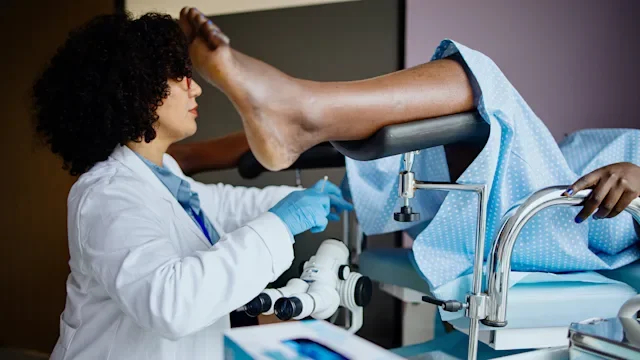Key takeaways:
“EOB” stands for explanation of benefits (EOB). It’s a document that’s generated when you use healthcare and details how you and your health plan share costs. It’s not a bill.
Compare your EOBs to your medical bills to keep track of your deductible and spending and to spot errors so your healthcare provider or health plan can correct them.
An EOB can help if you need to appeal a health insurance denial.
Of all the medical abbreviations, “EOB” is a common one. It stands for explanation of benefits. This is a document that arrives in the mail or to your secure online account that shows how you split your care costs with your health plan. It details how much money you may have to pay out of pocket for the services you receive.
You’ll only get an EOB from your health plan after you’ve had a medical service or bought equipment using your insurance card. An EOB is not a bill, but it details what to expect when you receive the bill or bills.
Below, we answer common questions about EOBs and explain how you can use them to find errors and resolve issues with your care team or health plan.
Search and compare options
What does an EOB statement look like?
EOBs don’t have a universal presentation. Their layout varies by insurer. But most EOBs include standard information like contact details and clarification that it isn’t a bill.
EOBs typically also show two to three tables displaying medical service costs, insurance coverage, and any expenses you need to pay. They show you the mathematical breakdown of how the insurer arrived at your out-of-pocket costs. Some EOBs use color contrast in their designs to better differentiate the portions that need closer attention.
Your health plan may reserve space on its EOB for definitions of common but confusing insurance terms such as deductible, copay, and coinsurance. Some health plans also include preventive care reminders.
Health insurers typically send EOBs to the person who pays the insurance premiums. But EOBs often include cost and coverage information about all the insured members in a household. So some states have rules protecting the healthcare privacy of people insured as dependents for sensitive services.
People with different kinds of insurance get different kinds of EOBs or healthcare statements. For example, if you have original Medicare, you get what’s called a Medicare summary notice every 3 months if you use healthcare services.
If you’re a Medicare enrollee with a private Part D or Medicare Advantage plan, you get EOBs instead. You may receive your EOBs monthly or per claim, in the mail or online.
Read more like this
Explore these related articles, suggested for readers like you.
What’s included in the EOB document?
The EOB is an overview of medical services you received. It explains the calculation of your benefits. Here is what you’ll typically find on your EOB:
1. Account summary — A brief snapshot of vital information, including:
Your name and address
Health plan member’s ID and group number
2. Details of the service — A description of the medical services you received, including:
Name of the service given
Provider name
Location and date of the service
A document reference number
Sometimes medical codes
3. Cost breakdown — The amount of the claim and how you and your insurer share the costs, including:
Amount billed: The amount of money your provider and/or the facility charged for the medical service
Allowed amount: How much the insurer can reimburse the provider
Paid amount: The amount your insurer actually paid the provider
Patient’s responsibility: Your share of charges, such as the copay or coinsurance you paid or may still owe (for an office visit or lab fees, for example)
Remark code, reason code, or notes section: Where your insurer explains more about an individual line item
4. Additional information, including:
Services not covered, if any
A glossary to clarify terms used in the EOB
State-specific directions on filing a grievance or appealing a claim
Information on how to get translations in multiple languages
Summary of year-to-date deductibles (You may have one each for in-network and out-of-network) and out-of-pocket maximums
When should you receive an EOB?
It’s not uncommon for an EOB to arrive within 30 to 60 days of receiving a medical service. If you don’t receive one after 60 days, call your health plan.
In some cases, it can take a long time between when you get an EOB and when you get an actual bill. Some states have responded to long delays by setting legal limits on medical billing times, as explained below.
You may not receive an EOB if you have a Medicare Advantage plan and:
You haven’t had a claim (gotten a healthcare service or item) during a reporting period
You are dually enrolled in Medicare and Medicaid
What should you do with an EOB?
You should review the EOB to:
Check that services are listed correctly and covered according to your plan benefits
Compare the EOB to its corresponding medical bills, receipts, or statements to confirm that all the charges match — and to make sure you aren’t double-billed or billed for a service you didn’t receive
Check progress on your deductible and out-of-pocket maximum spending to date
Also, ensure you’re not overpaying for services protected under the No Surprises Act. If you have private health coverage, the act protects you from surprise medical bills after January 1, 2022, resulting from:
Most emergency services
Nonemergency and balance bills from out-of-network providers at in-network facilities
Out-of-network air ambulance providers
The No Surprises Act is supposed to prevent you from getting shockingly high bills due to the above circumstances. If you’ve experienced any of these scenarios, check your EOBs to make sure your health plan did, in fact, cover the services at in-network rates. Otherwise, the EOB may show you as responsible for higher out-of-network payments. (Note that ground ambulance charges are excluded from the No Surprises Act.)
For surprise billing and other possible errors on an EOB, there are steps you can take:
Call the provider to let them know about the issue. It could be a coding or human error. For example, the EOB may mistakenly show that you need to pay for a COVID vaccine or covered preventative care. These costs should be free. Informing providers of this may be an easy fix.
If the provider or insurer doesn't correct the EOB, you can file an appeal.
The No Surprises Act established a new process called independent dispute resolution for certain out-of-network charges.
What happens if you receive an EOB but no bill?
Check the area on your EOB that shows the allowed charges and compare it to the amount paid by your insurer. If the amount you owe is zero, your health insurance may have covered the entire cost.
First, call your healthcare provider’s customer service number if you see a balance but haven't gotten a bill. If your health insurer is also your provider, you can find this number on your health insurer's member ID card.
If you have Medicare and are missing a bill from a Part A or Part B provider that appeared as a charge on your Medicare summary notice, you can call 1-800-MEDICARE (1-800-633-4227). If you have a missing bill and an EOB from a Medicare Advantage or Medicare Part D plan, call the plan directly.
In some places, an extensive lag time between getting an EOB and the corresponding medical bill means that you may not have to pay much of the missing bill at all. That’s because some states have laws enforcing medical billing time limits. In Texas, for example, healthcare providers have to waive most patient charges if they don’t bill within 11 months of providing the service. It’s part of a move toward reining in medical debt.
How long should you keep EOB documents?
There isn’t a formal rule, but it may help to follow healthcare provider practices — especially if you receive care for an ongoing medical condition or have complex billing. For example, the Florida Board of Medicine requires providers to hold medical records for at least 5 years.
Meanwhile, the IRS recommends keeping records at least 3 years for tax purposes. This may apply to you if you take a medical expense tax deduction.
If you aren’t receiving treatment for a chronic medical condition, you may want to shred and discard EOBs after one year. If you have an online account with your health plan, you can likely go paperless and access your past EOBs digitally, or you can scan and save them to your personal computer or smartphone to reduce paper. You also can request a copy of a missing EOB from your insurer.
States like New York and Wisconsin only send an EOB if there’s a balance due. So, a fully covered service like preventative care wouldn’t trigger an EOB. If you live in a state where you may get an EOB for a free flu shot that you’ve had, you might feel justified in shredding that EOB once you feel there’s no chance of getting a bill by mistake.
When you’re done with an EOB, don’t just recycle it or throw it in the trash. EOBs contain personally identifiable information, so it’s best to shred them to prevent fraud and identity theft.
Can you appeal the claim filed in an EOB?
Yes. If you have a health plan through the Affordable Care Act marketplace and the insurer denies the claim, you'll have 180 days or 6 months to file an internal appeal.
The insurer should complete the internal appeal process in:
60 days, for care you've already received
30 days, for services you haven't yet received
For a faster decision for an urgent medical condition, you can request an external review.
If your health plan denies the appeal, it must explain why within 30 days of the medical care you've already received.
If you have private insurance, you can typically initiate an appeal in writing and send it by mail, fax, or sometimes online. You usually have 180 days from when you received the EOB to appeal. The timeline for submitting an appeal can vary by state or the agreement you have with your insurer.
You can either fill out a member appeal form or write a letter. Call your health insurer’s member services department for more guidance on initiating an appeal.
The bottom line
Explanation of benefits (EOB) forms show how medical costs are shared between you and your health plan. They are not actual bills but a look behind the scenes detailing the amount you will see on your medical bills.
EOBs also show you how far you’ve come toward reaching your deductible and out-of-pocket maximum for the year. If a service isn’t covered, the EOB will tell you why. Compare your EOBs to their corresponding medical bills to ensure the charges are accurate. You can file an appeal if your health plan denies coverage.

Why trust our experts?


References
Aetna. (n.d.). Dispute and appeals process FAQs for health care providers.
BlueCross Blueshield of North Carolina. (n.d.). Understanding what you owe after visiting your provider.
CareFirst BlueCross BlueShield. (n.d.). Electronic explanation of benefits (EOB) frequently asked questions.
CareFirst BlueCross BlueShield. (n.d.). How to appeal a claim.
Centers for Medicare & Medicaid Services. (n.d.). No Surprises: Understand your rights against surprise medical bills.
Centers for Medicare & Medicaid Services. (2018). Reading your explanation of benefits.
Centers for Medicare & Medicaid Services. (2021). Helping people in Medicare Advantage Plans & Medicare drug plans understand their “explanation of benefits” (EOB).
Centers for Medicare & Medicaid Services. (2022). MA plan directory.
Centers for Medicare & Medicaid Services. (2022). Payment disputes between providers and health plans.
Chu, C.T. et al. (2020). Confidentiality in sexual healthcare for adolescents and young adults: Addressing disclosure in explanation of benefits.
Dunn, A., et al. (2021). A denial a day keeps the doctor away. National Bureau of Economic Research.
Fair Health Consumer. (n.d.). Code modifiers: How they affect you.
Florida Board of Medicine. (n.d.). How long must a healthcare practitioner maintain a patient’s records?
Greater Philadelphia Chapter. (2012). How long should I keep explanations of benefits from Medicare and health insurance companies? National Association of Productivity and Organizing Professionals.
Guttmacher Institute. (2022). Protecting confidentiality for individuals insured as dependents.
Healthcare.gov. (n.d.). Internal appeals.
Healthcare.gov. (n.d.). Preventive health services.
Internal Revenue Service. (2022). How long should I keep records?
Kaiser Permanente. (n.d.). Claims and appeals.
Medicare.gov. (n.d.). Contact Medicare.
Texas State Law Library. (2022). Medical debt.
U.S. Department of Health & Human Services. (n.d.). Section 1557: Ensuring meaningful access for individuals with limited English proficiency.
University of Utah Health. (n.d.). Explanation of benefits (EOB).

















